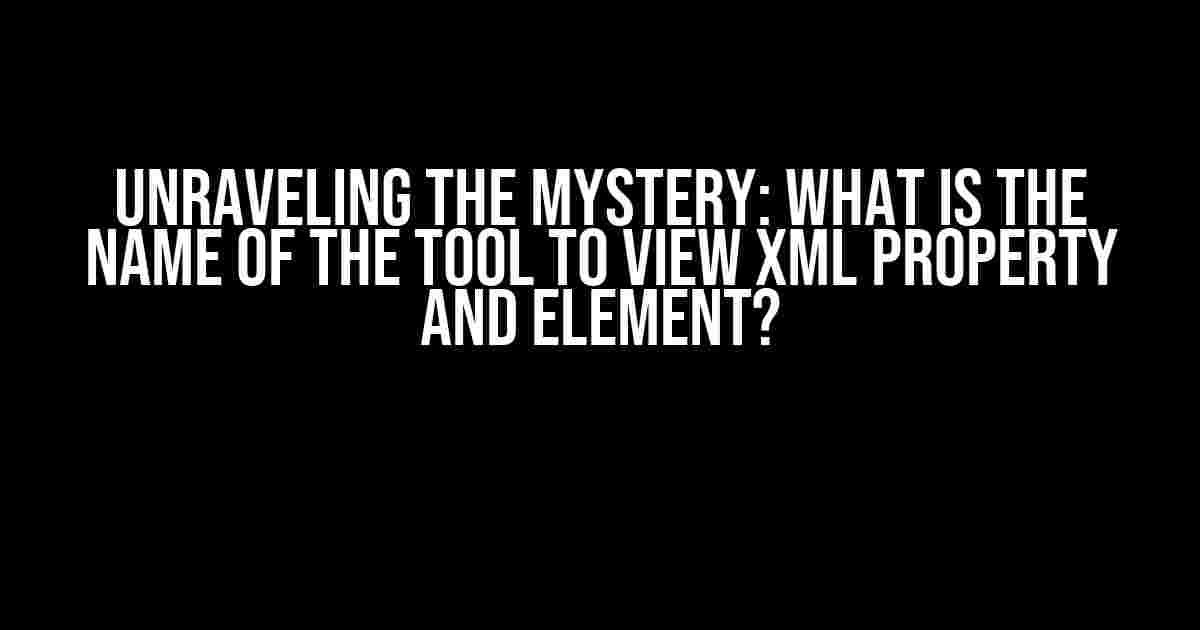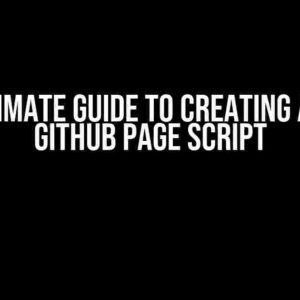Introduction
XML (Extensible Markup Language) has become an essential format for storing and exchanging data between systems, applications, and websites. As the use of XML grows, so does the need to efficiently work with it. One of the most common tasks when dealing with XML is to view and analyze its properties and elements. But have you ever wondered, what is the name of the tool to view XML property and element?
Understanding XML Basics
Before we dive into the tools, let’s take a quick look at the basics of XML. XML is a markup language that uses tags to define elements and their relationships. These elements can have attributes, which are additional information about the element. XML documents can be thought of as a tree-like structure, with elements and attributes forming the nodes.
<element> <!-- This is a comment --> <subElement attribute="value">Text</subElement> </element>
XML Properties and Elements
In the context of XML, properties and elements are often used interchangeably. However, it’s essential to distinguish between the two:
- Elements: These are the building blocks of an XML document, representing data or structures. Elements can have attributes, text content, or other elements as children.
- Properties: These are the attributes or characteristics of an element, providing additional information about the element. Properties can be thought of as key-value pairs attached to an element.
Tools to View XML Property and Element
Now that we’ve covered the basics, let’s explore some of the most popular tools to view XML property and element:
1. XML Editor
A popular choice among developers, XML editors provide a visual interface to edit and view XML files. Some popular XML editors include:
- Oxygen XML Editor
- XMLSpy
- Altova XML Editor
These editors allow you to view XML documents in a tree-like structure, making it easy to navigate and inspect elements and properties.
2. XML Viewer
XML viewers are lightweight tools that allow you to view XML files without the need for editing capabilities. Some popular XML viewers include:
- XML Viewer by oALTech
- XMLGrid
- XML Tree Viewer
These viewers typically provide a simple and intuitive interface to explore XML documents, often with features like syntax highlighting and element folding.
3. Browser Extensions
Many modern web browsers offer extensions that allow you to view XML files directly within the browser. Some popular extensions include:
- XML Tree by chrome.google.com
- XML Viewer by addons.mozilla.org
- XML Explorer by microsoft.com
These extensions enable you to view XML files with a single click, often with interactive features like expandable nodes and syntax highlighting.
4. Command-Line Tools
For those who prefer the command line, there are several tools that allow you to view XML files from the terminal. Some popular options include:
- xmllint (part of the libxml2 package)
- xmlstarlet
- xml2
These tools provide a range of options for parsing, validating, and inspecting XML files, often with the flexibility to customize the output.
Tips and Tricks
When working with XML, it’s essential to keep the following tips in mind:
1. Validate Your XML
Before attempting to view or analyze an XML file, make sure it’s valid. Use tools like xmllint or XML editors to validate the document against its schema or DTD.
2. Use the Right Tool for the Job
Choose a tool that fits your needs. If you need to edit the XML, an XML editor might be the best choice. For simple viewing, an XML viewer or browser extension might suffice.
3. Understand XML Namespaces
XML namespaces can be confusing, but they’re essential to understand when working with XML. Be aware of namespace declarations and how they affect element and attribute names.
Conclusion
In conclusion, there are many tools available to view XML property and element. From XML editors to command-line tools, the choice ultimately depends on your specific needs and preferences. By understanding the basics of XML and choosing the right tool, you’ll be well-equipped to work with XML files efficiently and effectively.
| Tool Type | Popular Options | Description |
|---|---|---|
| XML Editor | Oxygen XML Editor, XMLSpy, Altova XML Editor | Provides a visual interface to edit and view XML files |
| XML Viewer | XML Viewer by oALTech, XMLGrid, XML Tree Viewer | Allows you to view XML files without editing capabilities |
| Browser Extension | XML Tree by chrome.google.com, XML Viewer by addons.mozilla.org, XML Explorer by microsoft.com | Enables you to view XML files directly within the browser |
| Command-Line Tool | xmllint, xmlstarlet, xml2 | Provides a range of options for parsing, validating, and inspecting XML files from the terminal |
Now that you know the name of the tool to view XML property and element, it’s time to get started with exploring and working with XML files!
Frequently Asked Question
Get ready to uncover the secrets of XML property and element viewing!
What is the name of the tool to view XML property and element?
The answer is XML Editor or XML Viewer! These tools allow you to visualize and edit the properties and elements of an XML file with ease.
Is XML Editor a built-in tool in Windows?
No, XML Editor is not a built-in tool in Windows. However, you can use the built-in Notepad or Notepad++ to view and edit XML files. For more advanced features, you can download and install a third-party XML Editor or XML Viewer.
What are some popular XML Editor or XML Viewer tools?
Some popular XML Editor or XML Viewer tools include XMLSpy, Oxygen XML Editor, Eclipse, and XML Notepad. Each tool has its unique features and functionalities, so it’s worth exploring to find the one that best suits your needs!
Can I use an online XML Viewer to view XML properties and elements?
Yes, you can use an online XML Viewer to view XML properties and elements! There are many online tools available that allow you to upload or paste your XML code and view the properties and elements in a user-friendly interface. Some popular online XML Viewers include Code Beautify, XML Viewer, and Online XML Viewer.
Is it necessary to have programming knowledge to use an XML Editor or XML Viewer?
No, it’s not necessary to have programming knowledge to use an XML Editor or XML Viewer! These tools are designed to be user-friendly, and you can use them to view and edit XML properties and elements even if you’re not a programmer. However, having some basic understanding of XML syntax and structure can be helpful.




